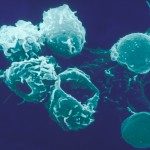Link to Pubmed [PMID] – 27618553
Nat. Immunol. 2016 Nov;17(11):1291-1299
Innate lymphoid cells (ILCs) have potent immunological functions in experimental conditions in mice, but their contributions to immunity in natural conditions in humans have remained unclear. We investigated the presence of ILCs in a cohort of patients with severe combined immunodeficiency (SCID). All ILC subsets were absent in patients with SCID who had mutation of the gene encoding the common γ-chain cytokine receptor subunit IL-2Rγ or the gene encoding the tyrosine kinase JAK3. T cell reconstitution was observed in patients with SCID after hematopoietic stem cell transplantation (HSCT), but the patients still had considerably fewer ILCs in the absence of myeloablation than did healthy control subjects, with the exception of rare cases of reconstitution of the ILC1 subset of ILCs. Notably, the ILC deficiencies observed were not associated with any particular susceptibility to disease, with follow-up extending from 7 years to 39 years after HSCT. We thus report here selective ILC deficiency in humans and show that ILCs might be dispensable in natural conditions, if T cells are present and B cell function is preserved.

